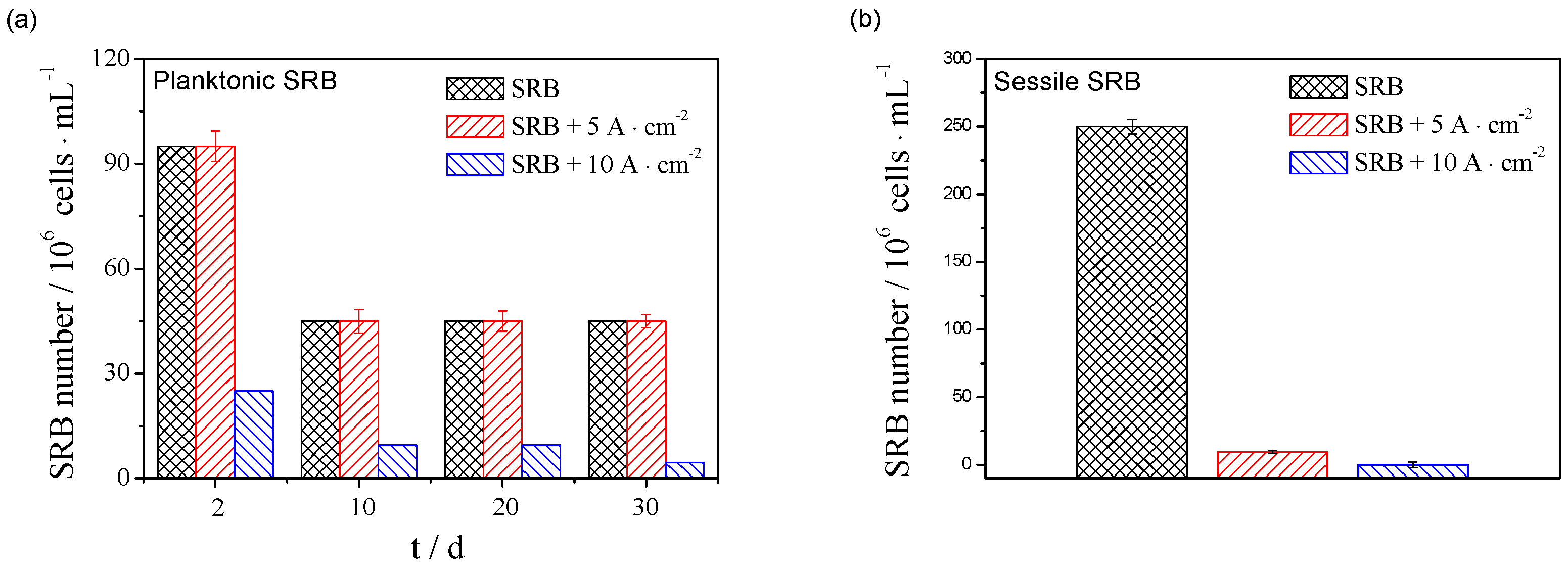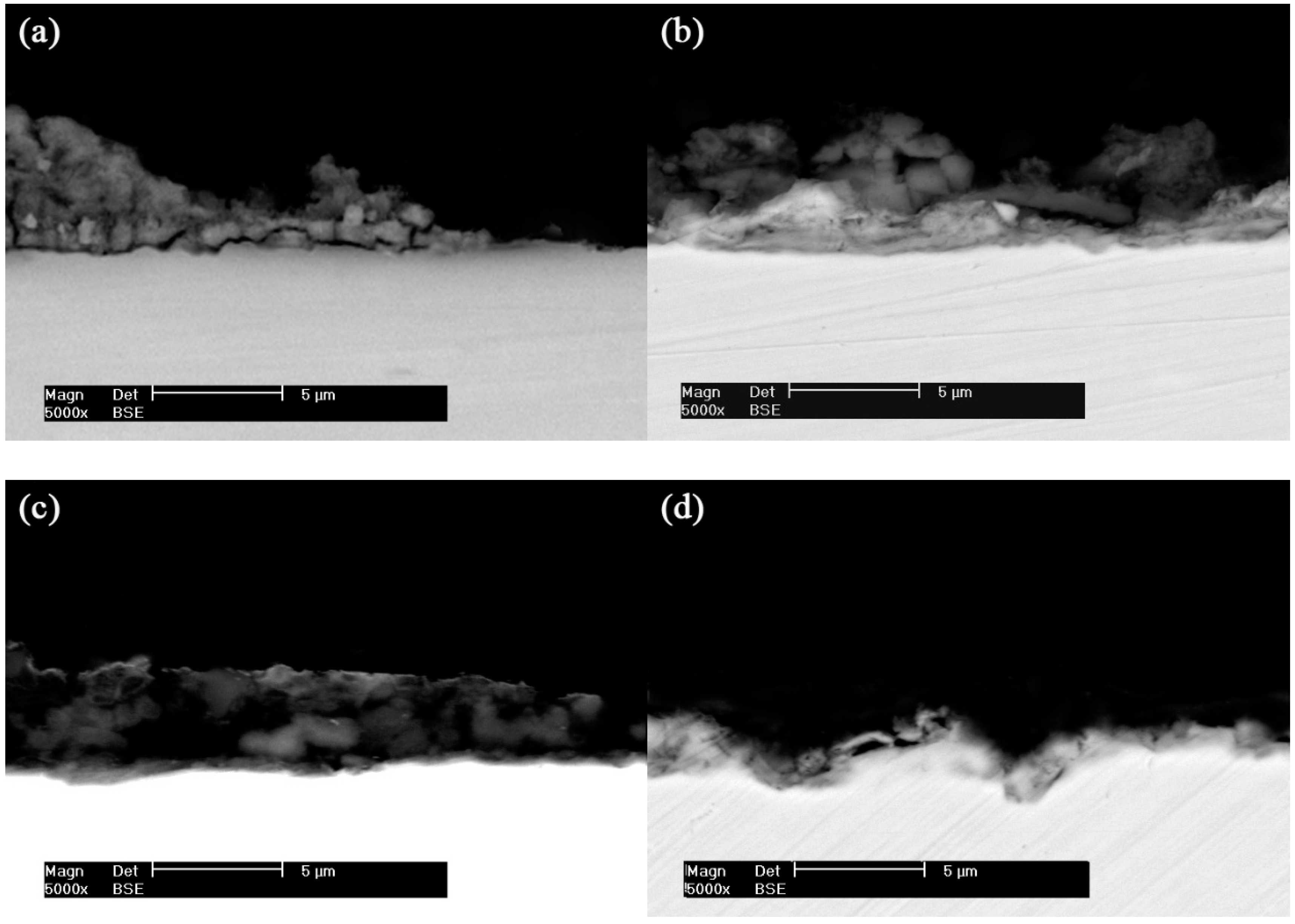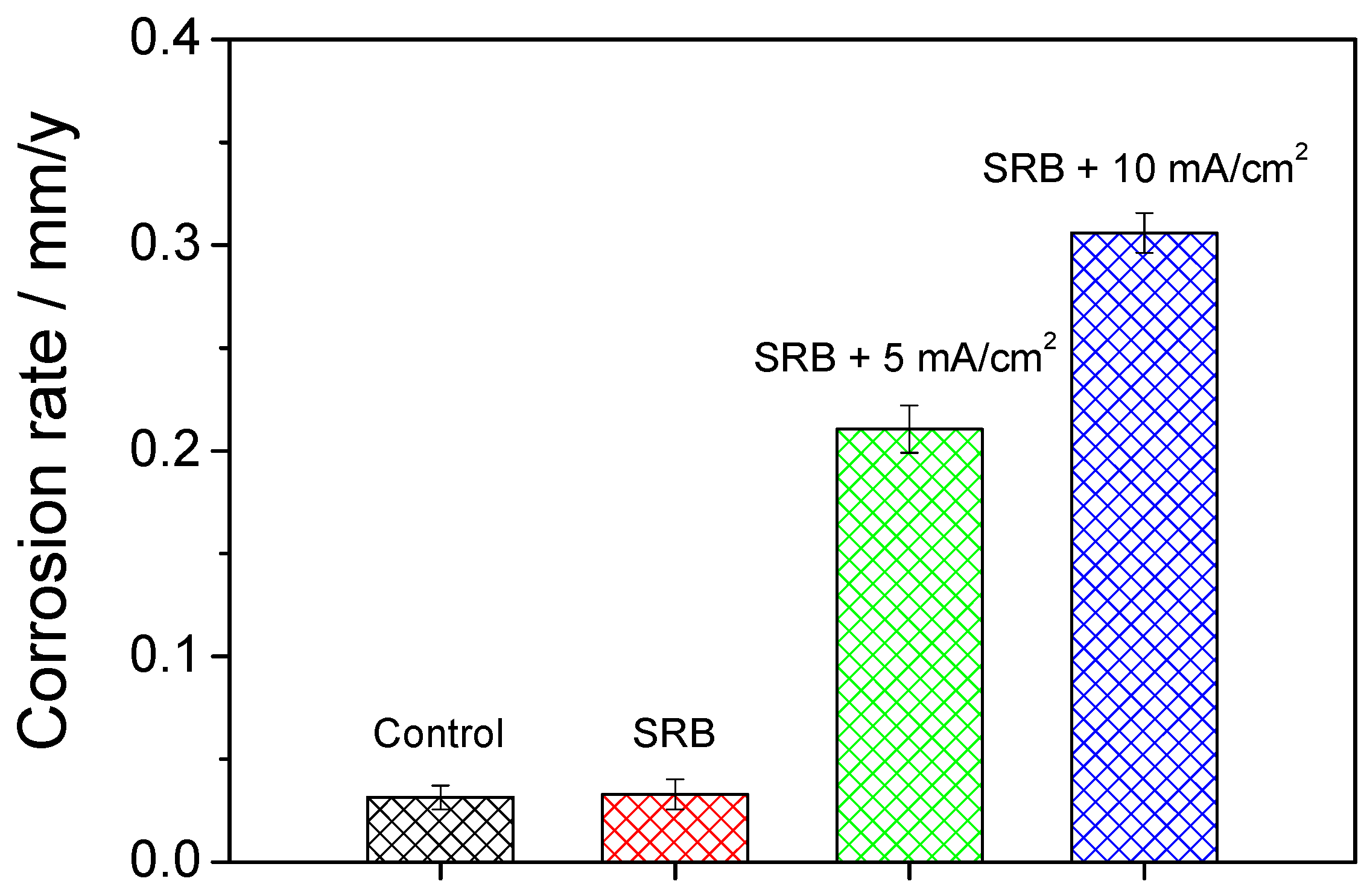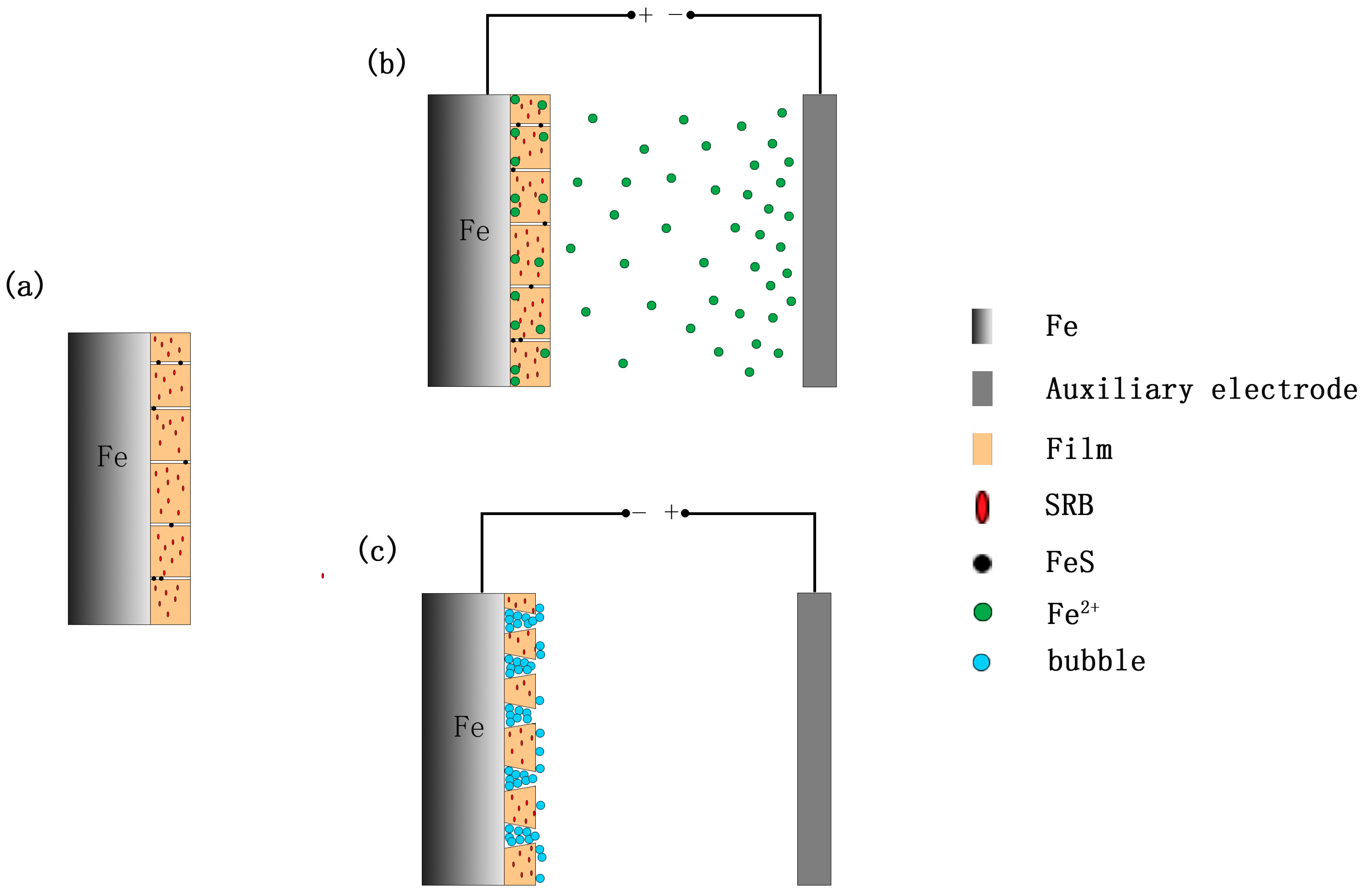Effect of Alternating Current and Sulfate-Reducing Bacteria on Corrosion of X80 Pipeline Steel in Soil-Extract Solution
Abstract
:1. Introduction
2. Materials and Methods
2.1. Coupon Preparation
2.2. Soil-Extract Solution Preparation
2.3. Microorganisms
2.4. Tafel Curve
2.5. Weight Loss
2.6. Morphological Characterization
3. Results
3.1. SRB Cell Counts
3.2. Micro-Analysis of the Coupon Surface
3.3. Tafel Curves
3.4. Weight Loss
4. Discussion
5. Conclusions
- (1)
- The 10 mA/cm2 AC current inhibits the growth and metabolism of planktonic and sessile SRB cells, indirectly enhancing the corrosion of the steel coupon.
- (2)
- Tafel results show that the AC current can enhance the corrosion of X80 pipeline steel coupon, and the corrosion current density of steel coupon with an AC current density of 10 mA/cm2 is almost 10 times as much as that without the AC current.
- (3)
- The gas bubbles generated in the negative half cycles of AC current result in the formation of crater-shaped corrosion morphologies. There is a significant difference in the corrosion behavior of the steel coupon with and without AC application in the presence of SRB. Even when the AC current density is only 5 mA/cm2, severe pitting corrosion still occurs. The corrosion type of steel coupon changes from pitting corrosion to localized corrosion with the increase of AC current density.
- (4)
- The mechanism of AC influenced corrosion in the presence of SRB is controlled by both iron active dissolution and film degradation.
Author Contributions
Funding
References
- Tang, D.Z.; Du, Y.X.; Lu, M.X.; Liang, Y.; Jiang, Z.T.; Dong, L. Effect of pH value on corrosion of carbon steel under an applied alternating current. Mater. Corros. 2015, 66, 1467–1479. [Google Scholar] [CrossRef]
- Tang, D.Z.; Du, Y.X.; Lu, M.X.; Jiang, Z.T.; Dong, L.; Wang, J.J. Effect of AC current on corrosion behavior of cathodically protected Q235 steel. Mater. Corros. 2015, 66, 278–285. [Google Scholar] [CrossRef]
- Wang, L.W.; Wang, X.H.; Cui, Z.Y.; Liu, Z.Y.; Du, C.W.; Li, X.G. Effect of alternating voltage on corrosion of X80 and X100 steels in a chloride containing solution-Investigated by AC voltammetry technique. Corros. Sci. 2014, 86, 213–222. [Google Scholar] [CrossRef]
- Chin, D.T.; Venkatesh, S. Study of alternating voltage modulation on the polarization of mild-steel. J. Electrochem. Soc. 1979, 126, 1908–1913. [Google Scholar] [CrossRef]
- Jiang, Z.T.; Du, Y.X.; Lu, M.X.; Zhang, Y.N.; Tang, D.Z.; Dong, L. New findings on the factors accelerating AC corrosion of buried pipeline. Corros. Sci. 2014, 81, 1–10. [Google Scholar] [CrossRef]
- Guo, Y.B.; Meng, T.; Wang, D.G.; Tan, H.; He, R.Y. Experimental research on the corrosion of X series pipeline steels under alternating current interference. Eng. Fail. Anal. 2017, 78, 87–98. [Google Scholar] [CrossRef]
- Li, Y.C.; Xu, C.; Zhang, R.H.; Liu, Q.; Wang, X.H.; Chen, Y.C. Effects of stray AC interference on corrosion behavior of X70 pipeline steel in a simulated marine soil solution. Int. J. Electrochem. Sci. 2017, 12, 1829–1845. [Google Scholar] [CrossRef]
- 8Guo, Y.B.; Liu, C.; Wang, D.G.; Liu, S.H. Effects of alternating current interference on corrosion of X60 pipeline steel. Pet. Sci. 2015, 12, 316–324. [Google Scholar] [Green Version]
- Xu, L.Y.; Su, X.; Yin, Z.X.; Tang, Y.H.; Cheng, Y.F. Development of a real-time AC/DC data acquisition technique for studies of AC corrosion of pipelines. Corros. Sci. 2012, 61, 215–223. [Google Scholar] [CrossRef]
- Goidanich, S.; Lazzari, L.; Ormellese, M. AC corrosion-part 2: Parameters influencing corrosion rate. Corros. Sci. 2010, 52, 916–922. [Google Scholar] [CrossRef]
- Goidanich, S.; Lazzari, L.; Ormellese, M. AC corrosion-part 1: Effects on overpotentials of anodic and cathodic processes. Corros. Sci. 2010, 52, 491–497. [Google Scholar] [CrossRef]
- Fu, A.Q.; Cheng, Y.F. Effects of alternating current on corrosion of a coated pipeline steel in a chloride-containing carbonate/bicarbonate solution. Corros. Sci. 2010, 52, 612–619. [Google Scholar] [CrossRef]
- Li, Z.; Li, C.Y.; Qian, H.C.; Li, J.; Huang, L.; Du, C.W. Corrosion behavior of X80 steel with coupled coating defects under alternating current interference in alkaline environment. Materials 2017, 10, 720. [Google Scholar] [CrossRef]
- Kuang, D.; Cheng, Y.F. Effects of alternating current interference on cathodic protection potential and its effectiveness for corrosion protection of pipelines. Corros. Eng. Sci. Technol. 2017, 52, 22–28. [Google Scholar] [CrossRef]
- Guo, Y.B.; Tan, H.; Meng, T.; Wang, D.G.; Liu, S.H. Effects of alternating current interference on the cathodic protection for API 5L X60 pipeline steel. J. Nat. Gas Sci. Eng. 2016, 36, 414–423. [Google Scholar] [CrossRef]
- Zhu, X.Y.; Liu, Y.H.; Wang, Q.; Liu, J.A. Influence of sulfate-reducing bacteria on the corrosion residual strength of an AZ91D magnesium alloy. Materials 2014, 7, 7118–7129. [Google Scholar] [CrossRef] [PubMed]
- Vargas, I.T.; Fischer, D.A.; Alsina, M.A.; Pavissich, J.P.; Pastén, P.A.; Pizarro, G.E. Copper corrosion and biocorrosion events in premise plumbing. Materials 2017, 10, 1036. [Google Scholar] [CrossRef]
- Xu, D.K.; Li, Y.C.; Song, F.M.; Gu, T.Y. Laboratory Investigation of Microbiologically Influenced Corrosion (MIC) of C1018 Carbon Steel by Nitrate Reducing Bacterium Bacillus licheniformis. Corros. Sci. 2013, 77, 385–390. [Google Scholar] [CrossRef]
- Xu, J.; Sun, C.; Yan, M.C.; Wang, F.H. Variations of Microenvironments with and without SRB for Steel Q 235 under a Simulated Disbonded Coating. Ind. Eng. Chem. Res. 2013, 52, 12838–12845. [Google Scholar] [CrossRef]
- Li, Y.C.; Xu, D.K.; Chen, C.F.; Li, X.G.; Jia, R.; Zhang, D.W.; Sand, W.G.; Wang, F.H.; Gu, T.Y. Anaerobic microbiologically influenced corrosion mechanisms interpreted using bioenergetics and bioelectrochemistry: A review. J. Mater. Sci. Technol. 2018, 34, 1713–1718. [Google Scholar] [CrossRef]
- Xu, J.; Jia, R.; Yang, D.Q.; Sun, C.; Gu, T.Y. Effects of D-Phenylalanine as a biocide enhancer of THPS against the microbiologically influenced corrosion of C1018 carbon steel. J. Mater. Sci. Technol. 2019, 35, 109–117. [Google Scholar] [CrossRef]
- Sun, C.; Xu, J.; Wang, F.H. Interaction of Sulfate-Reducing Bacteria and Carbon Steel Q 235 in Biofilm. Ind. Eng. Chem. Res. 2011, 50, 12797–12806. [Google Scholar] [CrossRef]
- Xu, J.; Wang, K.X.; Sun, C.; Wang, F.H.; Li, X.M.; Yang, J.X.; Yu, C.K. Effects of sulfate reducing bacteria on corrosion of the carbon steel Q235 under the disbonded coating by electrochemical impedance spectroscopy. Corros. Sci. 2011, 53, 1554–1562. [Google Scholar] [CrossRef]
- Wakelin, R.G.; Gummow, R.A.; Segall, S.M. AC Corrosion-Case Histories, Test Procedures, & Mitigation; Paper No. 565; NACE International: Houston, TX, USA, 1998. [Google Scholar]
- Von Wolzogen Kühr, C.A.H. Unity of anaerobic and aerobic iron corrosion process in the soil. Corrosion 1961, 17, 119–125. [Google Scholar] [CrossRef]
- McCollum, B.; Logan, K.H. Electrolytic corrosion of iron in soils. J. Franklin. Inst. 1913, 176, 97–99. [Google Scholar] [CrossRef] [Green Version]
- González, J.E.G.; Santana, F.J.H.; Mirzárosca, J.C. Effect of bacterial biofilm on 316 SS corrosion in natural seawater by EIS. Corros. Sci. 1998, 40, 2141–2154. [Google Scholar] [CrossRef]
- Starosvetsky, D.; Khaselev, O.; Starosvetsky, J.; Armon, R.; Yahalom, J. Effect of iron exposure in SRB media on pitting initiation. Corros. Sci. 2000, 42, 345–359. [Google Scholar] [CrossRef]
- Yin, Z.F.; Zhao, W.Z.; Bai, Z.Q.; Feng, Y.R.; Zhou, W.J. Corrosion behavior of SM 80SS tube steel in stimulant solution containing H2S and CO2. Electrochi. Acta. 2008, 53, 3690–3700. [Google Scholar] [CrossRef]
- Newman, R.C.; Rumash, K.; Webster, J. The effect of precorrosion on the corroison rate of steel in neutral solutions containing sufide-relevance to microbially infuluenced corrosion. Corros. Sci. 1992, 33, 1877–1884. [Google Scholar] [CrossRef]
- Castaneda, H.; Sosa, E.; Espinosa-Medina, M.A. Film properties and stability influence on impedance distribution during the dissolution process of low-carbon steel exposed to modified alkaline sour environment. Corros. Sci. 2009, 51, 799–806. [Google Scholar] [CrossRef]
- El Mendili, Y.; Abdelouasa, A.; El Hajj, H.; Bardeau, J.F. Phase transitions of iron sulphides formed by steel microbial corrosion. RSC Adv. 2013, 3, 26343–26351. [Google Scholar] [CrossRef]
- Kuang, D.; Cheng, Y.F. Understand the AC induced pitting corrosion on pipelines in both high pH and neutral pH carbonate/bicarbonate solutions. Corros. Sci. 2014, 85, 304–310. [Google Scholar] [CrossRef]
- Sato, N. A theory for breakdown of anodic oxide films on metals. Electrochim. Acta. 1971, 16, 1683–1692. [Google Scholar] [CrossRef]
- Ghanbari, E.; Iannuzzi, M.; Lillard, R.S. The mechanism of alternating current corrosion of API grade X65 pipeline steel. Corrosion 2016, 72, 1196–1211. [Google Scholar] [CrossRef]










| pH | Cl− | Ca2+ | Mg2+ | K+ | Na+ | Organics | Total Nitrogen | TOTAL SALT | |||
|---|---|---|---|---|---|---|---|---|---|---|---|
| 7.75 | 46 | 31 | 48 | 234 | 57 | 32 | 2 | 14 | 22600 | 150 | 464 |
| Element | Control (Position 1) | SRB (Position 2) | SRB + 5 mA/cm2 AC (Position 3) | SRB + 10 mA/cm2 AC (Position 4) |
|---|---|---|---|---|
| C | 39.32 | 42.82 | 46.07 | 42.98 |
| O | 36.02 | 26.72 | 23.65 | 24.73 |
| P | - | 7.7 | 7.23 | 6.89 |
| S | - | 5.8 | 5.58 | 3.39 |
| Ca | 2.04 | 1.52 | 1.48 | 1.47 |
| Si | 0.78 | 0.64 | 0.75 | 0.69 |
| Fe | 21.84 | 14.8 | 15.24 | 19.85 |
| Experimental Condition | Mean Roughness nm | RMS Roughness nm | RP-V nm |
|---|---|---|---|
| Control | 43 ± 3 | 58 ± 4 | 582 ± 21 |
| SRB | 78 ± 5 | 114 ± 5 | 1177 ± 32 |
| SRB + 5 mA/cm2 AC | 136 ± 9 | 204 ± 8 | 1676 ± 46 |
| SRB + 10 mA/cm2 AC | 278 ± 11 | 334 ± 13 | 1984 ± 69 |
| Time Days | Experimental Condition | Ecorr V | Icorr μA/cm2 | βa mV/Decade | βc mV/Decade |
|---|---|---|---|---|---|
| 2 | Control | −0.7219 | 1.67 | 65 | 196 |
| SRB | −0.8069 | 2.32 | 190 | 120 | |
| SRB + 5 mA/cm2 AC | −0.8771 | 2.74 | 265 | 123 | |
| SRB + 10 mA/cm2 AC | −0.9442 | 3.99 | 357 | 148 | |
| 10 | Control | −0.7328 | 0.30 | 83 | 118 |
| SRB | −0.7656 | 1.09 | 133 | 126 | |
| SRB + 5 mA/cm2 AC | −0.8148 | 4.12 | 253 | 230 | |
| SRB + 10 mA/cm2 AC | −0.9347 | 5.86 | 485 | 268 | |
| 20 | Control | −0.7431 | 0.73 | 99 | 169 |
| SRB | −0.7834 | 1.11 | 166 | 120 | |
| SRB + 5 mA/cm2 AC | −0.8613 | 4.63 | 312 | 165 | |
| SRB + 10 mA/cm2 AC | −0.9427 | 5.94 | 449 | 172 | |
| 30 | Control | −0.7379 | 0.90 | 91 | 143 |
| SRB | −0.7854 | 0.94 | 163 | 121 | |
| SRB + 5 mA/cm2 AC | −0.8498 | 6.02 | 388 | 212 | |
| SRB + 10 mA/cm2 AC | −0.9202 | 8.75 | 459 | 347 |
© 2019 by the authors. Licensee MDPI, Basel, Switzerland. This article is an open access article distributed under the terms and conditions of the Creative Commons Attribution (CC BY) license (http://creativecommons.org/licenses/by/4.0/).
Share and Cite
Qing, Y.; Bai, Y.; Xu, J.; Wu, T.; Yan, M.; Sun, C. Effect of Alternating Current and Sulfate-Reducing Bacteria on Corrosion of X80 Pipeline Steel in Soil-Extract Solution. Materials 2019, 12, 144. https://doi.org/10.3390/ma12010144
Qing Y, Bai Y, Xu J, Wu T, Yan M, Sun C. Effect of Alternating Current and Sulfate-Reducing Bacteria on Corrosion of X80 Pipeline Steel in Soil-Extract Solution. Materials. 2019; 12(1):144. https://doi.org/10.3390/ma12010144
Chicago/Turabian StyleQing, Yongchang, Yunlong Bai, Jin Xu, Tangqing Wu, Maocheng Yan, and Cheng Sun. 2019. "Effect of Alternating Current and Sulfate-Reducing Bacteria on Corrosion of X80 Pipeline Steel in Soil-Extract Solution" Materials 12, no. 1: 144. https://doi.org/10.3390/ma12010144




